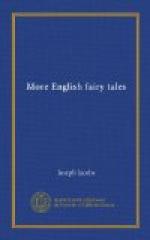In the course of the tale the chief thing to be noticed is the occurrence of rhymes in the prose narrative, tending to give the appearance of a cante-fable. I have enumerated those occurring in English Fairy Tales in the notes to Childe Rowland (No. xxi.). In the present volume, rhyme occurs in Nos. xlvi., xlviii., xlix., lviii., lx., lxiii. (see Note), lxiv., lxxiv., lxxxi., lxxxv., while lv., lxix., lxxiii., lxxvi., lxxxiii., lxxxiv., are either in verse themselves or derived from verse versions. Altogether one third of our collection gives evidence in favour of the cante-fable theory which I adduced in my notes to Childe Rowland. Another point of interest in English folk-narrative is the repetition of verbs of motion, “So he went along and went along and went along.” Still more curious is a frequent change of tense from the English present to the past. “So he gets up and went along.” All this helps to give the colloquial and familiar air to the English fairy-tale not to mention the dialectal and archaic words and phrases which occur in them.
But their very familiarity and colloquialism make them remarkably effective with English-speaking little ones. The rhythmical phrases stick in their memories; they can remember the exact phraseology of the English tales much better, I find, than that of the Grimms’ tales, or even of the Celtic stories. They certainly have the quality of coming home to English children. Perhaps this may be partly due to the fact that a larger proportion of the tales are of native manufacture. If the researches contained in my Notes are to be trusted only i.-ix., xi., xvii., xxii., xxv., xxvi., xxvii., xliv., l., liv., lv., lviii., lxi., lxii., lxv., lxvii., lxxviii., lxxxiv., lxxxvii. were imported; nearly all the remaining sixty are home produce, and have their roots in the hearts of the English people which naturally respond to them.
In the following Notes, I have continued my practice of giving (1) Source where I obtained the various tales. (2) Parallels, so far as possible, in full for the British Isles, with bibliographical references when they can be found; for occurrences abroad I generally refer to the list of incidents contained in my paper read before the International Folk-Lore Congress of 1891 and republished in the Transactions, 1892, pp. 87-98. (3) Remarks where the tale seems to need them. I have mainly been on the search for signs of diffusion rather than of “survivals” of antiquarian interest, though I trust it will be found I have not neglected these.
XLIV. THE PIED PIPER
Source.—Abraham Elder, Tales and Legends of the Isle of Wight (London, 1839), pp. 157-164. Mr. Nutt, who has abridged and partly rewritten the story from a copy of Elder’s book in his possession, has introduced a couple of touches from Browning.




